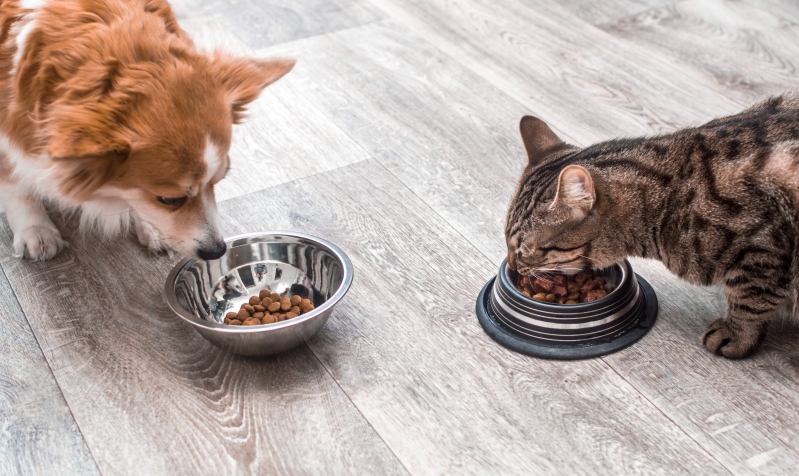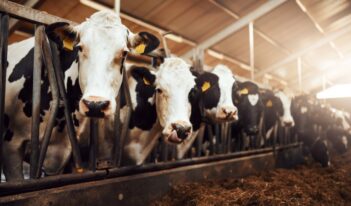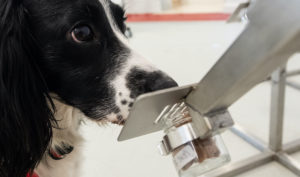
Regulators strive to keep our animal companions’ food safe, but gaps remain.
Fretting over food for your furry friend? You are not alone. An explosion of pet food options in the past decade—plant-based, vegetarian, natural, organic, gluten-free, grain-free, raw diet, novel protein, made in USA—has created an overwhelming number of choices.
Some brands market their pet food as better for older dogs or cats, while other brands target puppies and kittens. Still others claim their products are enriched with supplements such as “antioxidants, omega-3 fatty acids, glucosamine and chondroitin.” But do these labels really mean anything?
Consumers cannot have the same confidence in pet food labels that they do in labels for food made for human consumption. The Federal Food, Drug, and Cosmetic Act (FDCA) of 1938, administered by the U.S. Food and Drug Administration (FDA), was the first major federal legislation aimed at ensuring the safety and proper labeling of both human and animal food. But the law’s pet food provisions contain ambiguous terms and provide for limited oversight of the pet food industry.
Today, that industry is big business. Private-equity groups and mega-corporations gobble up brands such as Purina, Iams, Milk-Bone, and Eukanuba. The American Pet Products Association estimates that pet food and treat sales amounted to nearly $40 billion in 2019, with dog food comprising the bulk of sales. According to one estimate, if all the dogs and cats in America formed their own country it would “rank fifth in global meat consumption.”
In the late 1960s, the Association of American Feed Control Officials (AAFCO)—a nonprofit organization that sets “voluntary manufacturing and labeling guidelines” for pet food producers—tried to address some of the FDCA’s shortcomings and suggested more precise definitions and standards. The AAFCO continues to develop pet food safety and labeling standards. But because participation in the organization is voluntary, pet food producers are free to ignore the model regulations.
Many states have adopted the AAFCO Model Regulations for Pet Food, but compliance with these laws vary because local officials conduct all enforcement.
Calls for federal involvement in pet food regulation increased in 2007 after tainted ingredients imported from China killed over a dozen dogs and cats and sickened thousands of others. Four years later, Congress passed the Food Safety and Modernization Act (FSMA). This law expanded FDA’s power to issue pet food regulations.
One key provision of the FSMA, referred to as the Preventive Controls for Animal Food Rule, requires that pet food producers comply with “current good manufacturing practices.” But these good manufacturing practices—which include cleaning, pest control, and record-keeping guidelines—establish only minimum pet food safety and sanitation standards. Moreover, certain producers, such as home-based and “very small” pet food manufacturers, remain exempt from compliance, although state and local regulations may apply to them.
Proponents of the FSMA claim that tethering pet food safety and sanitation standards to current good manufacturing practices was a legislative “stroke of genius.” These supporters argue this connection gives manufacturers flexibility to incorporate innovative technology and determine for themselves which safety controls to implement to ensure compliance.
But the Pet Food Institute—members of which comprise nearly the entire U.S. pet food industry—maintains that although the FSMA is a step in the right direction, FDA has not provided sufficient guidance. The Institute also suggests that funding shortages hinder federal oversight and stymie state regulators who “shoulder much of FSMA compliance and enforcement responsibilities.”
Pet food does not require pre-market approval from FDA. The agency, however, requires that certain ingredients known as “food additives” receive approval before brands may use them in food products. But FDA defines food additives generally: as “any substance that directly or indirectly becomes a component of a food or that affects a food’s characteristics.”
Pet food manufacturers can sidestep FDA’s processes evaluating ingredients that fall under food additives’ broad coverage by using substances that are “generally recognized as safe” (GRAS). To obtain GRAS approval, a substance must either have existed in animal food before 1958 and commonly used since, or demonstrate its safety through a scientific study in a reputable journal.
FDA claims that the GRAS standard “is actually harder to meet than the standard required for food additives.” But it is ultimately up to individual pet food manufacturers to assess whether each ingredient meets the GRAS standard or should be categorized as a “food additive.” And some ingredients that originally met the GRAS standard—such as propylene glycol—have been later found to be dangerous to pets and have been prohibited by FDA.
After production, pet food is also subject to labeling requirements under FDA and the Federal Trade Commission (FTC). Under FDA regulations, pet food labeling must list certain percentages of named ingredients, the manufacturer’s name and address, and feeding directions based on the animal’s weight.
In addition, the FTC had issued the Dog and Cat Food Guides in 1999, which explained what counts as a misrepresentation in pet food labels and advertisements. These misrepresentations included a manufacturer’s false claim that its pet food won an award and an erroneous assertion that its pet food is “fit for human consumption,” but the FTC considered these guidelines as too repetitive of existing advertising standards and rescinded them in the same year.
Although nearly 80 percent of American pet owners claim “the quality of their pets’ food is as important as their own,” the comparative lack of pet food regulations suggests that pets may receive the shorter end of the stick. In 2019, FDA identified 16 dog food brands that possibly caused heart failure in dogs. And last fall, FDA issued another recall after the Louisiana Department of Agriculture and Forestry found certain pet foods contained unsafe levels of a toxin, even though no legal enforcement authorities suspect the manufacturers violated any existing regulation.
Although FDA seems willing to exercise its regulatory muscle recently by recalling potentially dangerous pet food, some veterinarians call for additional research into the safety of pet food ingredients—hoping to stop harmful products from reaching consumers in the first place.



